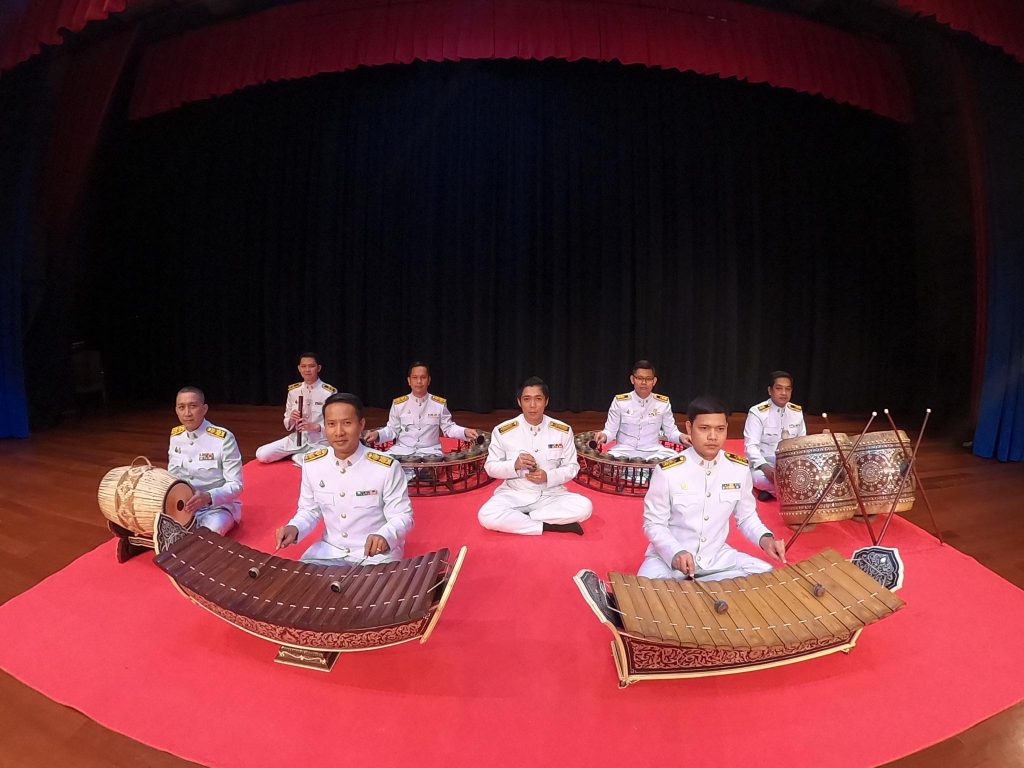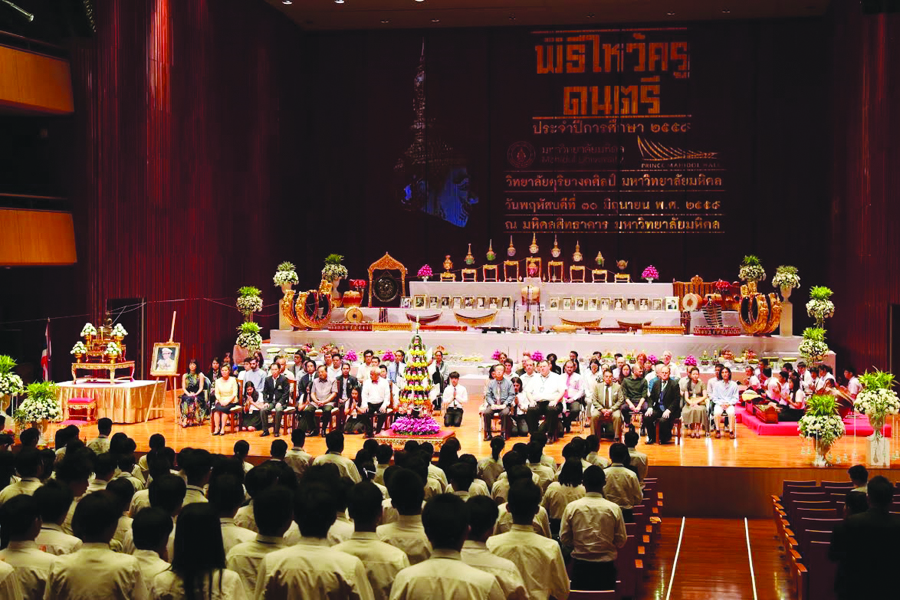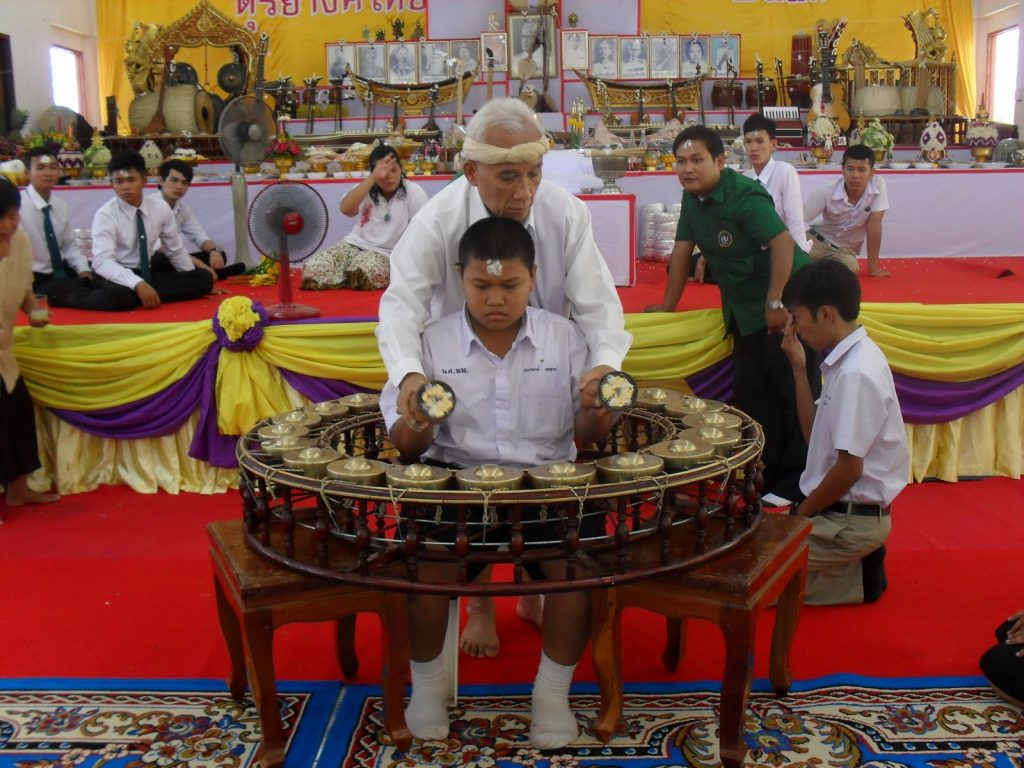Music for the Soul: Wong Piphat, the Thai Classical Orchestra

Musicians of the Thai Music Group, Fine Arts Department [cr. FB: Thai Music Group]
An independent country with a long history, Thailand possesses rich culture of language, cuisine, arts, and music, each of which is recognized as a national heritage. In this article, we explore Thai classical music, in particular the Piphat (ปี่พาทย์) orchestra.
History reveals that most traditional Thai musical instruments originated during the Sukhothai era (1249-1438), the first kingdom of Siam (the former name of Thailand). Musical ensembles were conceived in the Ayutthaya period (1350-1767), the second kingdom of Siam (1782-present) and reached their peak between 1868 and 1925 during the reigns of Kings Rama IV and VI, a period considered the golden age of Thai classical music.
Thai musical instruments are categorized into four main types based on the action of playing: Deed (plucking), Si (bowing), Tee (striking), and Pao (blowing).
Classical Thai music ensembles can be classified into three categories: Wong Piphat, Wong Khrueang Sai (วงเครื่องสาย), and Wong Mahoree (วงมโหรี), with wong meaning ensemble or band. Each band plays all three kinds of musical instruments – wind, string, and percussion – but in different combinations.
Percussion and wind instruments are the main constituents of Wong Piphat and include Ranad Ek (ระนาดเอก), alto bamboo xylophone; Ranad Thum (ระนาดทุ้ม), bass bamboo xylophone; Khong Wong Yai (ฆ้องวงใหญ่), a set of gongs in a vertical circular frame; Khong Wong Lek (ฆ้องวงเล็ก), a set of gongs in a horizontal circular frame; Ta-pone (ตะโพน), two-sided barrel drum laid horizontally on a wooden stand; and Klong Thad (กลองทัด), large drum played with sticks.
Wong Khrueang Sai features string instruments, such as the zither, alto, and soprano fiddles as the main components along with a wind instrument like a flute.
Wong Mahoree, meanwhile, is made up of all kinds of musical instruments – wind, string, and percussion – and can best be described as a combination of Wong Piphat and Wong Khrueang Sai.
The Piphat orchestra is the most common of these three ensembles and is considered the icon of Thai classical music. It is called upon to perform on most occasions, such as ordinations, house blessings, and religious ceremonies, and also accompanies classical plays and shows like Khon (โขน: classical masked dance), Likay (ลิเก: folk dance drama), and Nang Yai (หนังใหญ่: grand shadow puppet). The Piphat orchestra is also part of all royal events.
Types of Wong Piphat
The Piphat orchestra is further divided into eight sub-categories:
1. Wong Piphat Khrueang Ha (วงปี่พาทย์เครื่องห้า) – the principal band comprising the smallest number of instruments, namely Pi Nai (ปี่ใน) soprano oboe, Ranad Ek, Khong Wong Yai, Klong Thad, Ta-pone, and Ching (ฉิ่ง: small cymbals).
2. Wong Piphat Khrueang Khu (วงปี่พาทย์เครื่องคู่) has the same instruments as the former but also includes Ranad Thum, Khong Wong Lek, and Pi Nok (ปี่นอก), the smallest soprano oboe. Sometimes, these additional instruments may be replaced with Krap (กรับ), wooden rhythm clappers; and Klong Khaek (กลองแขก), Indian drums.
3. Wong Piphat Khrueang Yai (วงปี่พาทย์เครื่องใหญ่) is a modification of Wong Piphat Khrueang Khu through the addition of Ranad Ek Lek (ระนาดเอกเหล็ก), alto metal xylophone; and Ranad Thum Lek (ระนาดทุ้มเหล็ก), bass metal xylophone. The Klong Thad may sometimes be included.
4. Wong Piphat Nang Hong (วงปี่พาทย์นางหงส์) gets its name from a song “Nang Hong”, which was mostly played at funeral ceremonies in the past. The band features the basic instruments of the Wong Piphat but also includes the Pi Nai, Ta-pone and Klong Thad replaced by the Pi Java (ปี่ชวา) Javanese oboe, and Klong Malayu (กลองมลายู) Malay drum. However, its popularity has largely been surpassed by Wong Piphat Mon (วงปี่พาทย์มอญ).
5. Wong Piphat Mon comprises a number of musical instruments influenced by the culture of an ethnic group known as the Mon, who reside in parts of Myanmar and Thailand. It features the Khong Mon (ฆ้องมอญ) gong; Pi Mon (ปี่มอญ) oboe; Ta-pone Mon (ตะโพนมอญ) drums; and Poeng Mang Khok (เปิงมางคอก), a set of small long drums hung on a circular stand. Today, this band most commonly plays at funeral ceremonies, although it can also perform on auspicious occasions.
6. Wong Piphat Chatree (วงปี่พาทย์ชาตรี) accompanies folk plays in southern Thailand, such as Nora Chatree (โนราชาตรี) which is the traditional dance drama of the South, and Nang Ta-lung (หนังคะลุง) shadow puppet show. It consists of light instruments including the Pi (ปี่) oboe, Thon Chatree (โทนชาตรี), Klong Chatree (กลองชาตรี), and Khong Khu (กลองคู่) double gongs, Ching, and Krap Mai (กรับไม้) wooden rhythm clapper.
7. Wong Piphat Duek Dam Ban (วงปี่พาทย์ดึกดำบรรพ์) originated during the reign of King Rama V (1868 – 1910) and was named after “Duek Dam Ban” (ดึกดำบรรพ์), a royal theater operated by the King’s brother, Prince Narisaranuvattiwongse, who was a recognized master in several arts, such as architecture, literature, music, and theatrical plays. This specific band accompanies theatrical performances. It consists of instruments with low and soft tones such as the Ranad Thum, Khong Wong Yai, Khlui Ooh (ขลุ่ยอู้) wooden flute, Sor Ooh (ซออู้) alto fiddle, Ta-pone, and Ching.
8. Wong Piphat Sepha (วงปี่พาทย์เสภา; pronounced say-par) was introduced during the reign of King Rama II in a performance of ballad singing, the so-called Khab Sepha (ขับเสภา). The band features the Klong Song Nah (กลองสองหน้า) (a small long drum with two heads) that replaces the Ta-pone and Klong Thad in controlling the rhythm.
Wai Khru Piphat
Just as in other traditional Thai practices like dancing and boxing, every Thai musician must take part, at least once in their lifetime, in Pitee Wai Khru (พิธีไหว้ครู) or the Wai Khru Piphat (ไหว้ครูปี่พาทย์) ceremony.
The word wai (ไหว้) in Thai refers to a gesture of paying respect to seniors, teachers and sacred images or spirits by putting the palms together in front of one’s chest or forehead and bowing. Khru (ครู) is the Thai word for teacher and master.

The Thai classical orchestra at Mahidol University organizes an annual Wai Kru ceremony
[photo: Matichon]
Essentially, ‘Pitee Wai Khru Piphat’ (พิธีไหว้ครูปี่พาทย์) is a sacred ceremony to express gratitude and pay homage to musical instructors or teachers, as well as Phra Parakonthap (พระประคนธรรพ), the god of Thai classical music who is represented by the Ta-pone.
The ceremony, which has been passed down through the generations for centuries, is led by a Chao Pitee (เจ้าพิธี) – the ‘ruler of the ceremony’ – who will read Ong Kahn Wai Khru (โองการไหว้ครู) – a written script expressing gratitude and respect to teachers at the beginning of the ritual.
The selection of the Chao Pitee, regarded as the most significant figure in this sacred ceremony, is based on multiple criteria and requirements. In short, the candidate must possess superb skills, with an outstanding background in Piphat music. He must be able to play all master-level songs – the so-called Pleng Nah Phat (เพลงหน้าพาทย์) which are performed during Khon—a Thai classical masked dance performance. He must also have been ordained as a Buddhist monk for a period before starting to practice Pleng Nah Phat. Lastly, prior to fulfilling the duty of chao pitee, the selected person will have to attend a reading rehearsal of the Ong Kahn Wai Khru with senior teachers.
The ceremony setting features a complete set of Piphat instruments; masks depicting faces of musical gods; and offerings such as food, desserts, seasonal fruits and finely decorated flowers called Bai Si (บายศรี), all essentials for the Wai Khru ceremony. All these items are carefully placed at the front of the ceremonial ground while attendees sit at the back. The event starts with the Ong Kahn Wai Khru script reading and is followed by the offering of foods to gods and deceased music teachers. The time then comes for the jap mue (จับมือ) or hand holding ritual, the most important rite for all Piphat musicians.
For this rite, the initiate sits at the Khong Wong Yai. The chao pitee holds the initiate’s hands to perform Pleng Sa Thu Kahn (เพลงสาธุการ) – an instrumental song traditionally played at sacred ceremonies as an homage to deities. When pleng sa thu kahn has repeated three times, the Wai Khru Piphat ceremony is essentially complete, and the practitioner is officially declared a Thai musician, with all the qualifications to undertake further studies.

Jap mue ritual [cr. wasana3030.blogspot.com]
There are two groups of people who can skip the hand holding ceremony: 1) musicians who have already completed the highest levels of Piphat orchestra study, and 2) people who are attending the wai khru ceremony as a sign of respect and are not expecting to pursue a study in music. However, everyone is invited to join the blessing at the end of wai khru ceremony during which participants are anointed with holy powder on the forehead and sprinkled with sacred water on the head or body. This ritual is believed to chase away bad luck and bring fortune.
In sum, the Wai Khru Piphat ceremony aims to encourage Thai musicians to continue practicing their arts and improving their skills. Musicians also use the occasion of the ceremony to ask for blessings from teachers and the deities of music, as well as apologizing for any inappropriate behavior they might have demonstrated in the past.
For these reasons alone, all Thai musicians should take part in this auspicious ceremony at least once in their lives.
****************************
Reference
Tosa-nga, Narongrit. Jit Win Yarn Lae Lom Hai Jai Sam Nak Pipad [The life and soul of a Pipad orchestra]. Watthanatham Journal: Department of Cultural Promotion, vol. 57, no. 3, July-September 2018, p.22-29. Available at http://magazine.culture.go.th/2018/3/files/downloads/Ebook03_2018_Issue3.pdf.


